Open Channel Weirs - Volume Flow Measurements
Weirs can be used to measure flow rates in open channels and rivers - common for water supply and sewage plants.
Weirs are structures consisting of an obstruction such as a dam or bulkhead placed across the open channel with a specially shaped opening or notch. The flow rate over a weir is a function of the head on the weir.
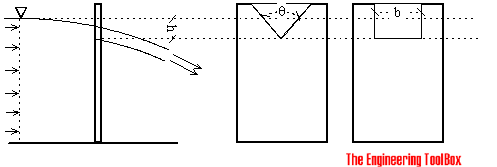
Common weir constructions are the rectangular weir, the triangular or v-notch weir, and the broad-crested weir. Weirs are called sharp-crested if their crests are constructed of thin metal plates, and broad-crested if they are made of wide timber or concrete. If the notch plate is mounted on the supporting bulkhead such that the water does not contact or cling to the downstream weir plate or supporting bulkhead, but springs clear, the weir is a sharp-crested or thin-plate weir.
Water level-discharge relationships can be applied and meet accuracy requirements for sharp-crested weirs if the installation is designed and installed consistent with established ASTM and ISO standards.
Rectangular weirs and triangular or v-notch weirs are often used in water supply, wastewater and sewage systems. They consist of a sharp edged plate with a rectangular, triangular or v-notch profile for the water flow.
Broad-crested weirs can be observed in dam spillways where the broad edge is beneath the water surface across the entire stream. Flow measurement installations with broad-crested weirs will meet accuracy requirements only if they are calibrated.
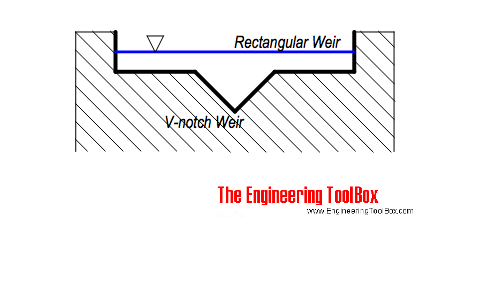
Other available weirs are the trapezoidal (Cipolletti) weir, the Sutro (proportional) weir and the compound weirs (combination of the previously mentioned weir shapes). By combining V-notch weirs with broad chested weirs - larger range of flow can be measured with accuracy.
Rectangular Weir
The flow rate measurement in a rectangular weir is based on the Bernoulli Equation principles and can be expressed as:
q = 2/3 cd b (2 g)1/2 h3/2 (1)
where
q = flow rate (m3/s)
h = elevation head on the weir (m)
b = width of the weir (m)
g = 9.81 (m/s2) - gravity
cd = discharge constant for the weir - must be determined
cd must be determined by analysis and calibration tests. For standard weirs - cd - is well defined or constant for measuring within specified head ranges.
The lowest elevation (h = 0) of the overflow opening of the sharp-crested weirs or the control channel of broad-crested weirs is the head measurement zero reference elevation.
Rectangular Weir Flow Rate Measurement Calculator
The Francis Formula - Imperial Units
Flow through a rectangular weir can be expressed in imperial units with the Francis formula
q = 3.33 (b - 0.2 h) h3/2 (1b)
where
q = flow rate (ft3/s)
h = head on the weir (ft)
b = width of the weir (ft)
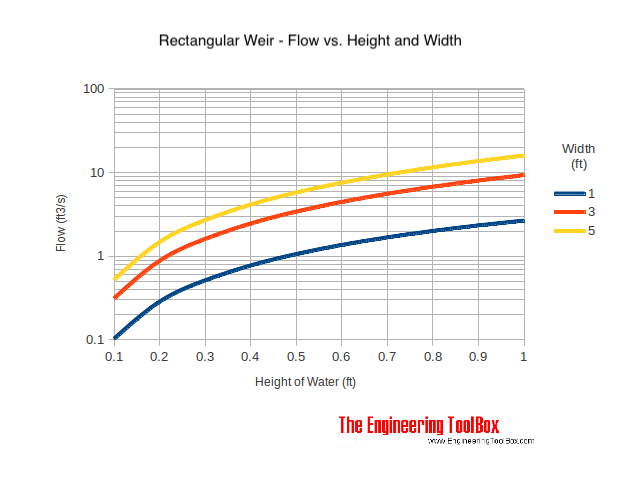
Alternative with height in inches and flow in gpm:
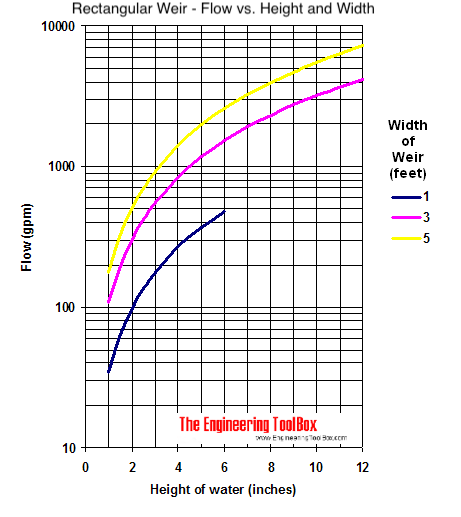
Triangular or V-Notch Weir
The triangular or V-notch, thin-plate weir is an accurate flow measuring device particularly suited for small flows.
For a triangular or v-notch weir the flow rate can be expressed as:
q = 8/15 cd (2 g)1/2 tan(θ/2) h5/2 (2)
where
θ = v-notch angle
Broad-Crested Weir
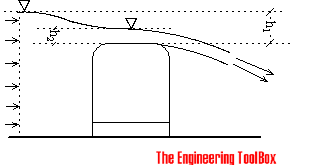
For the broad-crested weir the flow rate can be expressed as:
q = cd h2 b ( 2 g (h1 - h2) )1/2 (3)
Measuring the Levels
For measuring the flow rate it's obviously necessary to measure the flow levels, then use the equations above for calculating. It's common to measure the levels with:
- ultrasonic level transmitters, or
- pressure transmitters
Ultrasonic level transmitters are positioned above the flow without any direct contact with the flow. Ultrasonic level transmitters can be used for all measurements. Some of the transmitters can even calculate a linear flow signal - like a digital pulse signal or an analog 4 - 20 mA signal - before transmitting it to the control system.
Pressure transmitters can be used for the sharp-crested weirs and for the first measure point in broad-crested weir. The pressure transmitter outputs a linear level signal - typical 4-20 mA - and the flow must be calculated in the transmitter or the control system.
Related Topics
-
Flow Measurements
Flow metering principles - Orifice, Venturi, Flow Nozzles, Pitot Tubes, Target, Variable Area, Positive Displacement, Turbine, Vortex, Electromagnetic, Ultrasonic Doppler, Ultrasonic Time-of-travel, Mass Coriolis, Mass Thermal, Weir V-notch, Flume Parshall and Sluice Gate flow meters and more.
Related Documents
-
California Pipe Flow Metering Method
Calculate the discharge length from the open end of a partially filled horizontal pipe. -
Comparing Flowmeters
A limited comparison of flowmeter principles - regarding service, rangeability, pressure loss, typical accuracy, upstream pipe diameters, viscosity and relative costs. -
Flowmeters - Turndown Ratios
Turndown ratio (Rangeability) can be used to compare flow measurement devices like orifices, venturi meters etc. -
Fluid Flowmeters - Comparing Types
An introduction to the different types of fluid flowmeters - Orifices, Venturies, Nozzles, Rotameters, Pitot Tubes, Calorimetrics, Turbine, Vortex, Electromagnetic, Doppler, Ultrasonic, Thermal, Coriolis. -
Froude Number
Introduction to the Froude Number. -
Velocity-Area Flowmetering
Flow rate or discharge in an open conduit, channel or river can be calculated with the velocity-area principle. -
Waste Water Piping - Flow Capacitiy vs. Dimension
In sewage piping and pumping systems the fluid flow rate must be kept within certain limits to avoid operating problems. -
Weirs Flow Meters - Standards
Standards for weir flow measurements.




